Well, that's not the way we roll here at Big Time Attic. When I'm writing a story, I like to keep only the simplest structure in mind so that I'm free to add more interesting scenes, lines, and characters as they strike me as appropriate. Similarly, to keep myself from driving a story off the rails, I like to keep in mind only the simplest guidelines.
Story Triangle
I just kind of made this up as I was writing so that I could have something to picture in my mind to let me know if the story was well balanced without having to examine everything too closely. I like to do things in as few drafts as I can (one, if possible) and having to go back and tinker with stuff just makes me twitchy.
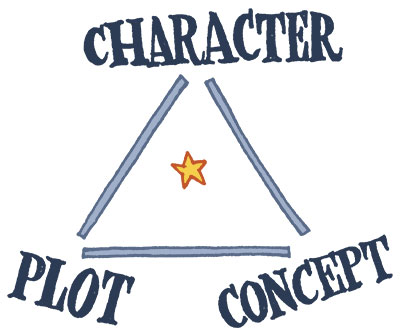
Simply put, it's a triangle with the words "Plot", "Character", and "Concept" at each corner. For about a day, I actually drew it on the pages that I was writing on, but to be perfectly honest, it's not that hard to remember. Whenever I'm writing comics -- that is to say, doing layouts -- I try to make sure that every page at least, and every panel, if I can, resides in that sweet spot right in the center of the triangle. I want to make sure that at all times the story includes in roughly equal measure all three of those elements, so that it doesn't become too much of one thing and forget about the rest. Too much plot and it's just a whodunit. Too much character and it's a pointless psychological profile. Too much concept and it's a role-playing game manual.
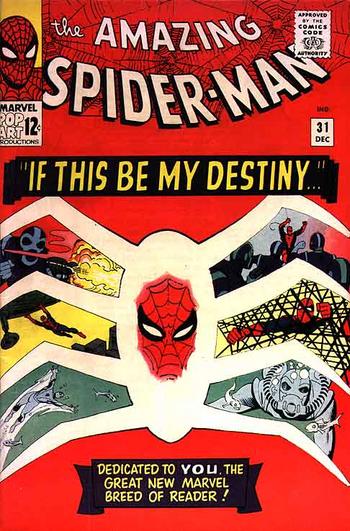
Here's an example from one of my favorite comic stories of all time: Spider-Man #s 31-33, "If This Be My Destiny" by Stan Lee and Steve Ditko. This story in my mind is one of the best superhero stories ever told, in large part because it sticks right to the center of our triangle. Here's the story: Peter Parker's Aunt May is ill, and Peter is worried that she might die. So there's your character. But why is she ill? Well, she's always been a little fragile, as we all know, but this time it's because she received a blood transfusion from her well-meaning nephew, and the radioactivity in his blood that makes him Spidey is killing her. There's your concept-- this story couldn't exist as a non-superhero story. Now, the doctor and Peter's biology professor say they can help her, but they need a certain radioactive isotope that's being shipped across the country. But just as the isotope makes it to New York, the Master Planner (actually Dr. Octopus) steals it to use it in his latest plan. Aha, plot. The triangle is completed!
The story plays out in relatively predictable ways, if you've ever read a superhero comic before, but every event in the story is made more important by being relevant to all three story corners. A by-the-numbers plot twist, such as Peter being delayed, is made much more intense because of Peter's devotion to his aunt and his fear that she will die. His human fear that she will die is made extraordinary because it's indirectly due to him being a superhero. And his being a superhero is the only reason he can do anything about his Aunt's condition. If any of these elements were dropped, the story would fall apart, and because it requires all three elements, it's a good Spider-Man story, not just a good story that happens to involve Spider-Man.
If you've never read "If This Be My Destiny", go and buy the Essential Spider-Man Book 2-- it's in the middle somewhere. Get ready to feel ridiculous because you're getting a little teary when a man in a red and blue costume talks out loud to convince himself not to give up while he's pinned by a big metal machine.
Certainly more precise story guidelines exist than the Story Triangle, but when I'm sitting down to write, I feel like it's the only thing I have to keep in mind to make sure the story stays interesting. Usually I (and presumably you) will instinctively notice that something doesn't seem right, but it's the triangle that gives us an (extremely short) checklist to figure out where the problem lies.
Happy writing!

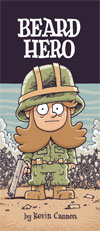
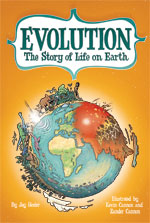
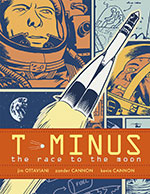
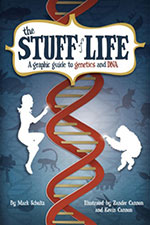
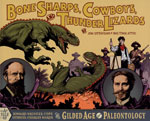
3 comments:
If this be your greatest blog post ever?
Aunt May is one part deux ex machina, one part MacGuffin, and two parts Geritol.
I'll try to remember this, I need a simple framework like this (that makes so much sense) to evaluate stuff I'm still continually rewriting.
I used to own those issues of spiderman but I sold them all to buy pre-hero monster comics! yay!
Post a Comment